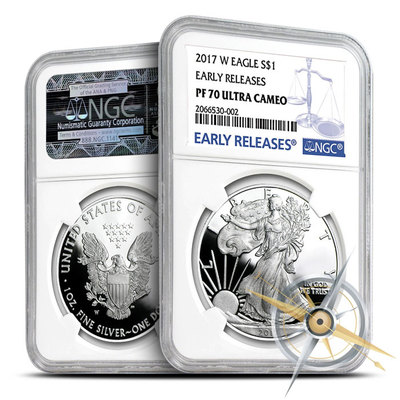Label Designations for Graded Coins and Rounds
Coin collecting has long been a popular hobby, but until the mid 1900’s there was not a standardized scale for grading the quality of a coin. Dr. William Sheldon pioneered a system of grading in 1948 that is still used by numismatists to quantify the physical state of a coin. Today, gold and silver coins are graded and certified by third party companies like the Numismatic Guarantee Corporation (NGC), the Professional Coin Grading Service (PCGS), the American Numismatic Association Certification Service (ANACS), and the Independent Coin Graders (IGC).
These independent firms are well-trusted within the industry for providing unbiased evaluation of coins and rounds. Many collectors enjoy investing in certified coins and rounds because their guaranteed grade provides security and authenticity. Additionally, coins and rounds with higher grades are more likely to appreciate in value over time.
How are Coins and Rounds Graded?
The grading organizations listed above are staffed with highly skilled professionals in the art and science of coin grading. Each coin and round is personally assessed and assigned a grade according to a detailed set of standards. These standards are based on many factors, including the Sheldon numerical scale that was created in 1949 by Dr. William Sheldon. On this scale, coins and rounds are graded from 1 to 70, with 1 being poor condition and 70 being flawless.
After a grade is assigned, the coin or round is individually sealed into a plastic capsule (also called a slab or holder) to preserve its graded condition. Slabs are labeled with information about the coin and its grade, along with the organization that assigned the grade.
Label Designations
Learning about the label designations of graded coins and rounds helps you better understand the investment you’re making. Let’s take a look at the key words and phrases you may find on slab labels.
- Mint State: Referred to as MS, mint state coins are those that were struck and never circulated. They are graded on a scale from MS60 to MS70. Only a fraction of coins produced are graded MS70, making them highly sought after and often more pricey.
- Brilliant Uncirculated: This too means that a coin was never circulated. The term BU is used by mints, while the term MS is used by third party grading services.
- Proof: A proof coin is made with a special striking process that results in a mirror-like field and frosted devices. Proof coins and rounds are among the highest quality. A proof coin or round is identified by a “PF” or “PR” in front of the grade, depending on the grading organization. For instance, you might find an NGC slabbed coin with a grade of PF69 or a PCGS slabbed coin with a grade of PR70.
- Cameo: Because proof coins and rounds have a shiny background and frosted designs, they are sometimes referred to as having a cameo effect. You might see “CAM” on the label to signify this effect, or “DCAM” to signify a deep cameo effect.
- Early Releases: This is the NGC’s designation for a coin received by the firm within 30 days of the first release of a new coin issue.
- First Strike: This term has the same meaning as Early Releases, but it is used by PCGS.
With Early Releases and First Strike, note that the terms refer to coins that are shipped from the mint within 30 days of their official release. This does not necessarily correlate to the order in which they were struck. For this reason, the NGC replaced the phrase “First Strike” with “Early Releases.”
Once familiar with this terminology, you’ll be able to determine the meaning of the information on a slabbed coin’s label with ease. This allows you make better purchasing decisions as you continue to invest in precious metals.






